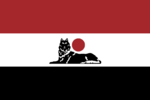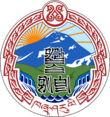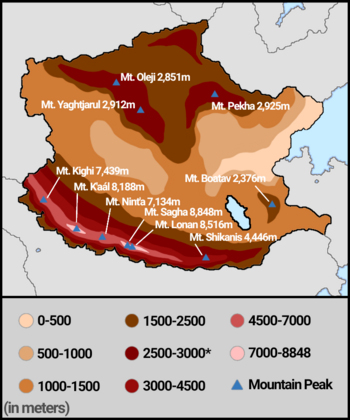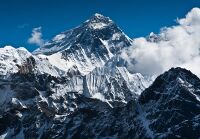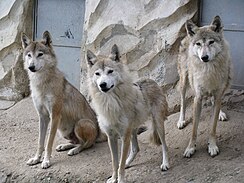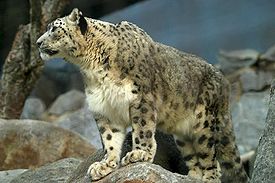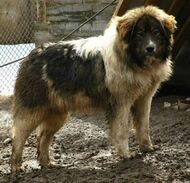Hondonia
The Kingdom of Qazhshava Duchærulde tsæ K'ajsharuli དུཅཱརུལ྄དེ ཙཱ ཁཞ྄ཤརུལི دچرلده تس قژشو (دُچَرُلده تسٓ قَژشَرُلِ) | |
|---|---|
| Motto: "Esæw Aghe Arzdæne!" "ཨེསཱཝ྄ ཨགྷེ ཨར྄ཟ྄དཱནེ" "Toghether we are unstopable!" | |
| Anthem: "Vuwheis Aghæwde!" "ཝུཝ྄ཧིས྄ ཨགྷཱཝ྄དེ" "The Wolf's Pact!" | |
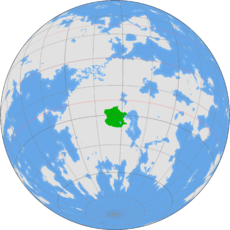 Location of Hondonia (green) in Thrismari (grey) | |
 | |
| Capital | |
| Working language | Lakkathan (Qazhshavan) |
| Official languages |
|
| Demonym(s) | Qazhshavan Qash |
| Government | Federal Absolute Monarchy |
• King (Duch) Duchæ | Kayid Makoshvi Ghalvayu ཀཡིད྄ མཀོཤ྄ཝི གྷལ྄ཝཡུ |
| Area | |
• Total | 992,650 km2 (383,260 sq mi) |
| Population | |
• 2018 estimate | 42,909,690 |
| GDP (PPP) | 2018 estimate |
• Total | 720.64 bn $ACU 1 441.29 ꞣ |
• Per capita | 17 000 $ACU 34 000 ꞣ |
| HDI (2018) | high |
| Currency | Kyærat ʞ (1ʞ = 0.50 ACU$) (QZK) |
| Time zone | -2 |
| Date format | dd-mm-yyyy |
| Driving side | right |
| Internet TLD | .qs |
The Kingdom of Qazhshava (Qash/Lakkathan: Duchærulde Tsæ K'ajsharuli ; IPA: /dutʃɤ̞ɾuldɛ tsɤ̞ k'aʒ̊:aɾuli/) is a country in the Anterian continent of Thrismari, it borders the Marmar sea to the east, the countries of Mehrava to the west, Encessia to the south, Gassasinia to the south-east, and the United Faerie Peoples to the north-weast, and Abul to the north. Qazhshava is in the MTCO (Midwestern Thrismari Cooperation Organization) linking Gassasinia with Mehrava and the rest of the MTCO.
The Capital, Karakach, is the second largest city in the country, after Baasinsey, it borders the biggest lake in the county, lake Lakot (Qash/Lakkathan: Tebza Lakot ), from which the two great rivers form, the rivers go through the entire country and all the way to Gorabo thorugh Mehrava.
Ethymology
The name Qazhshava comes from the word 'Qash' which comes from Ardugud Qazh sha, who was the leader of the Qazhshavans when they migrated into the Ghodab desert (Qash/Lakkathan: Ghodabis Makod ) around the year 1160, the Mehrani people who he ruled over took the name Qazhshans, and the land he ruled became Qazhshava - mehrani for the land of Qazhshans
History
Recent History
Geoghrapy
Mountains
Biodiversity
Qazhshava's biodiversity is quite diverse due to the various climates.
Noteble animals one can find are:
Herbavoars/Omnivoars:
Elk, Red Deer, Roe Deer, Wild Boar, Brown Bear, Lakkalic wolfs, Wild Yak, Wild Water Buffalo, Takalan Tahr, White-Bellied Musk Deer, Takalan Musk Deer (in the higher elevated areas), Lakkathan chevrotain, Gaur, Bison, Wild Ghalarul Donkey, Wild Ghalarul Horse, Zali Antelope, Argali, Mouflon, Takalan Pika, Four-toed jerboa, Hedgehog, Forest dormouse, farious rabbit and hare species (notebly the Woolly hare), Lakkathan Gray Langur, Farious Squirrle species (notebly the Black giant squirrel), Raccoon*, Asian Badger, Racoon dog, Pygmy hog, and others.
Carnivorous:
Thrismari Golden Cat, Lynx, Manul cat, Leopard cat, Marmar Tiger, Red Fox, Steppe fox, Snow Leopard, Lakkalic Civet, Genet, Jackal, Dhole, Lakkathan Marten, Mountain weasel, Takalan Weasel, Steppe polecat, Otter and others.
Politics
The King Of Qazhshava
the current King (Duch) of Qazhshava is Duchæ Kayid (Makoshvi) Ghalvayu ( ཀཡིད྄ (མཀོཤ྄ཝི ) གྷལ྄ཝཡུ ).
Born in Voarsaghalæ, Lanshan region to the Ghalvayu dynasty while his parents were on tour. Moved back to Baasinsey. Mother died in 1985, moved to Karakach. 1995, his father died from poisson, he became the King (Duch). 1997 redraws the administrative map. ~ ~ ~.
Administrative Divisions
The Administrative Divisions structure in Qazhshava goes as:
- The Duchrul
- Areas
- States
- Regions
- Counties
- Municipalities
- Cities/Towns/Villages
- Municipalities
- Counties
- Cities of Importance
- Mahlas
- Regions
- States
- Areas
Areas of Qazhshava
The areas of Qazhshava are Devided into three Geghraphically bases divisions
1. Lakkatha - (Qash/Lakkathan: Lak'ataruli) The Southern part of Qazhshava, it is the most mountainous and coldest part of the Country, it also contains Lake Lakot from which the great rivers sprout out from. This area also has the biggest number if Tjar'dze believers, and the biggest Tjar'dze monestary in Qazhshava - '"Palith Lavrul Monestary"'. Just West of Lake Lakot is where one of the oldest people in the region live, the Xewexetans, who speak a compleatly indegenous language, and are the inventors of the Xitshat script, off of which the Lakkalic script is based of.
2. Ghodab Desert - (Qash/Lakkathan: Ghodabis Makod) The central part of Qazhshava, it is the dryest, least populated and flatest area of the Country, it has a lot of historical and cultural sites, like the old city of Sadjamlar, the monestary of Qazh Sha, the town of Bod, the Largest city in Qazhshava - the city of Yoanrul, and more. This area is where Ardugüd Qazh Sha Brought his followers in the 12th century, building up the Cities of Mehrghalgh and Sadjamlar.
3. Zaloaps'ana - (Qash/Lakkathan: Zaloaps'anæruli) The Northern part of the Country, it isnt particulary flat or mountainus, except for the moutnains to the west, the area has very strong cold winds, it also has a lot of cultural sites, mainly some of the largest Tjan'dze monestaries in the country.
States of Qazhshava
| No. | Name | Lakkathan (Qazhshavan) | Dur | Capital | Flag | Map | Area (km²) | Population 2019 | License plate | Note |
|---|---|---|---|---|---|---|---|---|---|---|
| 1 | Baasinsey City | བཨསིན྄སེཡ྄ གྷལཱ Baasinsey ghalæ |
Chanæ Kshayirshvi | 
|

|
N/A | 8 000 000~ | BA | Royal Capital. | |
| 2 | Karakach City | ཀརཀཅ྄ གྷལཱ Karakach ghalæ |
Kazghan Tofshvi | 
|

|
N/A | 6 000 000~ | KA | Oficial capital. | |
| 3 | Lakkatha State | དུརུལ྄ ལཁཏརུལི Durul Lak'ataruli |
Ghaya Mnamheshvi Ikki Ghalvayu |

|

|
N/A | - | LK | Largest state, huging the Takal mountin chain. | |
| 4 | Ghalarul State | དུརུལ྄ གྷལརུར྄ Durul Ghalærul |
Kiyar Tsænruldze | Template:Country data Yoanrul | 
|

|
N/A | - | GR | Most of it is a flat steppe joining into a moutnain to the north and the Ghodab desert to the west. |
| 5 | Ghodab State | དུརུལ྄ གྷོདབིས྄ མཀོད྄ Durul Ghodabis Makod |
Ebriham Machænashvi | Template:Country data Mehærghalæ | 
|

|
N/A | - | GM | Hugs the Ghodab desert and follows the great rivers going into Mehrava. |
| 6 | Zalistan State | དུརུལ྄ ཟལ྄རུལི Durul Zalruli |
Djohar Nimirshvi | File:Flag of Zalistan .png | 
|
N/A | - | ZR | Mostly uneven Mountains and holds the largest amount of Tjan'dze temples. | |
| 7 | Aps'ana State | དུརུལ྄ ཨཕ྄སན྄རུལི Durul Aps'anruli |
Shakim Moadedshvi | 
|

|
N/A | - | AR | Smaller state along the norhtern mountain holding the largest trading port in Qazhshava. | |
| 8 | Al-Shaka State | དུརུལ྄ ཤཀགྷཱ Durul Shakaghæ |
Mohamed Burhan | Template:Country data Al-Diza | 
|

|
N/A | - | SG | Smallest state, population is 80% arabic. |
Foreign relations
| Country/Union/Autonomous District | Status | State of relations | Mutual Embassies | Visa Requirement | Formal Relations Began | Qazhshavan Ambassador | Foreign Ambassador |
|---|---|---|---|---|---|---|---|
| Very Positive | Both in the Midwestern Thrismari Cooperation Organization, and historical ties. | Baasinsey/Al-Bashar | No | 1920 | Batr Tæghdze | Munsif al-Salloum | |
| Positive | Country from SU. Suplies Qazhshava with surtein millitary equipment. | Karakach/Wenelstadt | On Arival | 1934 | Badra Kalmikshvi | Franz Knoerr | |
| Neutral | Country in Southern Thrismari | Karakach/Götburg | Yes | 1946 | Avor P'tsineshvi | Anna Jacobsen | |
| Positive | Neighboring Nations, Big history, Lakkalic minorities in Encessia. | Karakach/Lonue | On Arival | Batbayan Atiwashvi | |||
| Very Positive | After Their Unificatoin, a Gibrelt traveler found gold in the rivers of Qazhshava and brought the new to Gbarielland, causing a lot of Gibrelts to emigrate to Qazhshava, due to which the nations' relations improveed significantly. | Baasinsey/Vailhims | No | 1928 | Samuil Hyawdze | Gyannya Saitan | |
| Possitive | Country from SU, Trading partners. | Yoanrul/Ermeelsteet | On Arival | 1972 | Yoana Pshikashvi | Randvi Horbrens | |
| Positive | Neighboring Nations, both in the Midwestern Thrismari Cooperation Organization. | Karakach/Jabiyah | No | 1949 | Boris Boaræshvi | Pierre Ghorayeb | |
| Positive | Both are in the Midwestern Thrismari Cooperation Organization. | Karakach/Al-Zohrah | No | 1920 | Ian Mohamedshvi | Hakim Saidi | |
| Positive | Historical allies since the 1910s. | Baasinsey/Kentasi | On Arival | 1910 | Ýama Tushtoshvi | Elena Pejic | |
| Positive | Since the 1940s, Kistolia and Quazhshava have been major trade partners | Karakach/Hesoluo | On Arival | 1945 | Zahyir Janshvi | Fe’iro Kin | |
| Neutral | Has companies working in Zalistan, Qazhshava. Briefly recognized Free Zalistan and loosened relations with MTCO. | Yoanrul/Zozava | Yes | 1969 | Mohamed Voldze | Katrien Duren | |
| Very Positive | Neighboring Nations, both in the Midwestern Thrismari Cooperation Organization, and big historical ties. | Baasinsey/Azhtanan | No | 1987 | Mililyude Koarlardze | Razdân Razâqand | |
| Positive | Sebronia exports heavy machinery to Qazhshava. | Karakach/Deimeka | On Arival | 1924 | Kazan Ahchakarshvi | Melfœ Leςen | |
| Slightly Positive | Both are in the Midwestern Thrismari Cooperation Organization. | Yoanrul/Syropolis | No | 1965 | Ali Tebzadze | ||
| Positive | Large Trading Partners. | Karakach/Oryshevsk | On Arival | 1962 | Yuriy Melyanenko | Ghazan Ashtishvi |
Military
As of 2020, Qazhshava has an amry of 450 000 active-duty personel and 840 000 reserved on stand-by who can be deployed when needed. Equiped with 3 940 tanks (many of which are old models), 2 490 Infantry Fighting Vehicles, 6 220 Armored Personel Carriers, 1200 MRAPs, x Artillery, 2 940 Air Defence Vehicles, along with 1 045 Combat Aircraft (including Helicopters), and a 107 strong navy (excluding river flotilla). The Qazhshavan Army is well-equiped and well-trained. Military spending of Qazhshava is about 3.9% of the GDP with a budget of 56,2 billion ghoshes (28,1 billion $ACU).
The Qazhshavan Army is mostly active in the Zalistan and parts of the Aps'ana regions. A force is awlays kept ready for deploiment if needed .
Police
Demoghraphics
Demographic chart of Lakkatha (2018)
The mojority population of Qazhshava are Lakkalics, there are still a lot of acutal Mehrani-Qash people, who are mainly populated throughoout the Centeral area of the country, large concentration in the central ![]() Mehrava border, and throughout the desert and steppe, with the biggest concentrations being in the
Mehrava border, and throughout the desert and steppe, with the biggest concentrations being in the ![]() Ghodab State,
Ghodab State, ![]() Ghalarul state and around the big cities such as
Ghalarul state and around the big cities such as ![]() Baasinsey and
Baasinsey and ![]() Karakach.
Karakach.
The Lakkathans, who are the current majority Lakkalics in Qazhshava, they are located mainly in the Takel Mountain of the south where the ![]() Lakkatha State is located (minorities in
Lakkatha State is located (minorities in ![]() Mehrava and
Mehrava and ![]() Encessia).
The Rish are Lakkalic people related to but seperate from the Lakkathans, they speak a language influenced by The Xewexetan and Khaanese languages, and live in an area in
Encessia).
The Rish are Lakkalic people related to but seperate from the Lakkathans, they speak a language influenced by The Xewexetan and Khaanese languages, and live in an area in ![]() Lakkatha State known as Ghan-Rishruli (Translates as "Grand Land of the Rish"), which is devided between 4 regions in the beforesaid
Lakkatha State known as Ghan-Rishruli (Translates as "Grand Land of the Rish"), which is devided between 4 regions in the beforesaid ![]() Lakkatha State known as Rishruli, Holanruli, Lanshanruli and Sæbrus Rishruli.
The Zal are located thoughout the northwestern mountains (minority in
Lakkatha State known as Rishruli, Holanruli, Lanshanruli and Sæbrus Rishruli.
The Zal are located thoughout the northwestern mountains (minority in ![]() Mehrava too). The Zal are Zaloaps'an lakkalics, closely relatedbut seperate fro mthe Lakkathans, along whit the other Zaloaps'ans (the Aps'an, Didza, Lavynne, Lian and Nanuk) are located in the northern moutnains, wiht the largest population of Zalies are in the File:Flag of Zalistan .png Zalistan State, capital of which is
Mehrava too). The Zal are Zaloaps'an lakkalics, closely relatedbut seperate fro mthe Lakkathans, along whit the other Zaloaps'ans (the Aps'an, Didza, Lavynne, Lian and Nanuk) are located in the northern moutnains, wiht the largest population of Zalies are in the File:Flag of Zalistan .png Zalistan State, capital of which is ![]() Ch'azan. The Ap'san are the only other Zaloaps'ans who have their own state, being
Ch'azan. The Ap'san are the only other Zaloaps'ans who have their own state, being ![]() Aps'ana State, capital of which is
Aps'ana State, capital of which is ![]() Anrav.
Anrav.
The Khaanese poeple are indeginous to Qazhshava, being one of the three original peoples here (along with the Lakkalics and Xewexetans), they are located in the Mountains of Qazhshava, which the highest concentrations in the Takal mountain, and in Tjan'dze Comunities in File:Flag of Zalistan .png Zalistan State.
The Xewexetan poeple are one of the original poeoples of Qazhshava (along with the Lakkalics and Khaanese as said above). They dont speak a single unified language, but a bunch of Dialects, the remaning 858,193~ish Xewexetans left in the World are located in the Xewexetruli region of ![]() Lakkatha State.
Lakkatha State.
The Balhi people, are an ethnic group related to the Mehrani-Qash people who've mixed with the now extinct Bakti lakkalic people, they speak an unrelated language, originating from the Bakti language. Currently these peple live in the autonomous region of Balhistan, it is split into two parts, of which 2/3 are in Qazhshava and 1/3 in ![]() Mehrava
Mehrava
The others cathegory is mainly Arabs, of which there are three goups, the Gassasinian, the Goraboese and the Northern Arabs (who live in the ![]() Al-Shaka State), and, Gibrelts, Arsyans and Encessians.
Al-Shaka State), and, Gibrelts, Arsyans and Encessians.
| Group | Name |
|---|---|
| Lakkathan | Kuch'kana, Lakkatha, Miyn, Meyv, Sofokli |
| Zaloaps'an | Aps'an, Didza, Lavynne, Lian, Nanuk, Zal |
| Rish | Holan, Lanshan, Rish |
Culture
National Symbols
The Lakkalic Wolf (Qash/Lakkathan: Lak'alæn Vuwh ):
It is the National Mammal of Qazhshava, the symbolism originates with the Lakkalic people, who see the wolf as a great and sacred creature, and the embodimate of the god Warida, who is the highest diety of the Tjan'dza beliefes, even tho most Lakkalic people worship Islam or Christianity, major Tjan'dze followers still remain. Wolfs are still allowed to be hunted, but black wolfs are forbiden to kill, they are seen as the animal embodiment of Warida when she has serious buissness on earth and isn't playing around, it is believed that a person who killed a black wolf would be cursed with bad luck for the rest of their live.
The Snow leopard (Qash/Lakkathan: Yaghtjar , Barz ):
It is on the same rank as National Animal, but isnt displayed as such, though The Snow Leopard is the State animal of Zalistan. In Mehrani-Qash and Lakkalic beliefes the Snow Leopard is a sacred symbol. In Lakkalic traditions the Snow Leopard is seen as magical creatures symbolising power and agility, and it has served as symbols of Rish tribes for centuries. In the Tjan'dze faith it is also a symbol of agility and the animal embodiment of the goddess of the hunt, Atjema.
The Golden Eagle (Qash/Lakkathan: Tjamæn Swah )
It is the Natoinal Bird of Qazhshava, it is both a Mehrani-Qash and Lakkalic Symbol, symbolizing a lot of diferent things, most overlaping wiht both cultures. In the Tjan'dze faith, it is seen as, the goddess of the hunt, Atjema's (Godess of the Hunt) eyes in the skies and pets.
The Rishan / lakkathan shepherd (Qash/Lakkathan: Rishruliis Ovatjir , 'Rishtjir'):
It is an ethnic dog bread originating in the Rish regions in the state of Lakkatha. It is also the most common dog ourside city areas, used by shepherds and for guard dogs, a very prized national symbol of Qazhshava.
Language
The official language of Qazhshava is the Lakkathan (sumtimes internationally refered to as Qazhshavan) language (Qash/Lakkathan: Lak'ata menæ), which is the most spoken language of the Lakkalic language-gorup.
General B. Davadzshvi's speach (1912) in English, Lakkathan and Mehrani-Qash:
| English | Lakkathan (Qazhshavan) | Mehrani-Qash |
|---|---|---|
| General B. Davadzshvi's speach: | Gheneral B. Dævædzshviis haymæde: | Zanêran B. Davadzshaviz shvid: |
| Stand up! | An! | Shandub! |
| Soldiers, we'll go inside the enemy trenches.
Once we're there, the ridge will defend us. |
Voayake, shay ýe ghemaru ænæ nwoarisde ok'ope.
Næsa shay aghe hwoa, haræbide ýe djaræw shey. |
Sazârs, vegâr anzad dâr anârmi jhen.
Onkve dêr, dâr ridze vil demêr ruz. |
| Forward means Freedom!
Stopping means Death! if we die, let's die like heroes! |
Tsæp'waredmide hæw Elave!
Zdamide hæw T'raghæ! Kwa shay t'aramaru, nay t'aramaru k'es Baghane! |
Favâd mâyn Farezâ!
Sartâpvi mâyn dâid! iv vedâi, lâdz dâi lâkh herêzar! |
| There are no two deaths, but it's impossible with none. | Armwæ twæ t'raghæbe, aw ej arak'eshts'a lewr ares. | Dêr âr nâr tôrdâid, bad êtz imjhanêvor vid nâra. |
| If you're afraid, Forward!
If you doubt, Forward! If you dont know what do to, Forward! |
Kwa ghre siærshænashre, tsæp'wared!
Kwa ghre sýanashre, tsæp'wared! Kwa ghre arzæshre k'o k'æ yæshre, tsæp'wared! |
Ivyâr afâd, Favâd!
Ivyur dousht, Favâd! Ivyur dunkhowsh vât todôr, Favâd! |
| When your bullets end, you have a bayonet.
If the bayonet breaks, you have hands! |
K'aa kurshumede she arawre, mwæshre shtik.
Kwa shtikde ghe shch'æw, mwæshre harwe! |
Venyôr buretz ind, yurhâv o bahjhâned.
Ivdâr bahjhâned bahrêkz, yurhâv handârz. |
| If your hands break, you have Theet! | Kwe harwe she ghe shch'æwre, mwæshre doaze! | Ivyôr handârz bahrêkz, yurhav tahiz! |
| Allah, and Qazhshava invoke us! | Allah, di K'azhsharuli mikaow shey! | Ala, ârd Qazhshavâ evâkh ruz! |
| Lakkalics, Yanarzar (Yoanrul) is infornt of us! | Lak'ale, Yoanrul ej tsend shey! | Lakhâiz, Yanarzar iz infârâv ruz! |
| If we Win, Tuhrtsia will fall! | Kwa ýe halæmaru, Tærts'ruli ýe chæræw! | Ivve vin, Tôhrajhan vil fahâl! |
Lakkalic
Mehrani-Qash
Xewexetan
Examples of Xewexetan Music:
Song of the Bison
Song of the horse
Sonf of the Spring
